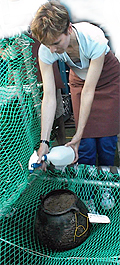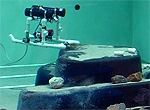Excavation
The art and science of getting to the artifacts
The art and science of getting to the artifacts
 Excavated artifact
Excavated artifact-- a chamber pot.
Image courtesy MIT DeepArch.
Excavation is the careful exposure and, in many cases, removal of archaeological artifacts. It's a tricky process at Port Royal where over 300 years of sediments combine often with poor visibility and ocean surge to make the work slow and tedious.
In shallow waters - The simplest and most gentle way to clear sediment cover is by hand-fanning. In this technique, divers use their own hands to fan water and "blow" sediments aside. When that's not enough, mechanical blowers or vacuums are used, but they aren't as gentle as the human touch.
 Film clip of excation at Port Royal - Coming soon.
Film clip of excation at Port Royal - Coming soon.
In deeper waters - It's certainly no easier 3 miles down where groups like DeepArch must rely on ROVs to do the same work. How does the ROV expose and retrieve artifacts with as much dexterity as human hands? Imagine handling fine china with the arms or other instruments attached to an ROV.
 Visitors can try their hand at guiding an ROV to excavate submerged artifacts in our ROV testing tank.
Visitors can try their hand at guiding an ROV to excavate submerged artifacts in our ROV testing tank.
Image from the Ocean Institute.
All that you can do at OI
At the Ocean Institute
Visitors can try their own hand at techniques such as ... at the Ocean Institute.
On-line visitors can try the following methods at home or school: • Artifact Retrieval
• Lifesaver® Release
In shallow waters - The simplest and most gentle way to clear sediment cover is by hand-fanning. In this technique, divers use their own hands to fan water and "blow" sediments aside. When that's not enough, mechanical blowers or vacuums are used, but they aren't as gentle as the human touch.
In deeper waters - It's certainly no easier 3 miles down where groups like DeepArch must rely on ROVs to do the same work. How does the ROV expose and retrieve artifacts with as much dexterity as human hands? Imagine handling fine china with the arms or other instruments attached to an ROV.
 Visitors can try their hand at guiding an ROV to excavate submerged artifacts in our ROV testing tank.
Visitors can try their hand at guiding an ROV to excavate submerged artifacts in our ROV testing tank.Image from the Ocean Institute.
All that you can do at OI
Visitors can try their own hand at techniques such as ... at the Ocean Institute.
On-line visitors can try the following methods at home or school: • Artifact Retrieval
• Lifesaver® Release
Where to find more information:
Institute of Nautical Archaeology
To learn more about excavations around the world.
Texas A&M University
DeepArch
To learn more about DeepArch excavations in deep water.
MIT Deep Water Archaeology Research Group, DeepArch
A Matter of Convenience
All that's an artifact is not gold. So what's a chamber pot?
By Christine A. Powell, Nautical Archaeology at Texas A&M
Archaeology
More about wreck formation, surveying, measuring and excavation.
from Shipwreck!, a former exhibit at the Miami Museum of Science
Techniques for Underwater Archaeology and Maritime Preservation
Detailed information for the public.
Background Paper by the U.S. Congress, Office of Technolgy Assessment
Produced in collaboration with Scripps Institution of Oceanography.
Website by Earthguide.
© 2003-2004 by the Ocean Institute
and the Regents of the University of California.
All rights reserved.
Last modifed Monday, December 10, 2004
